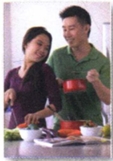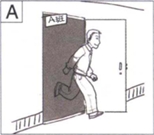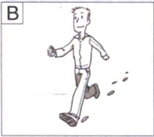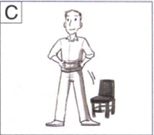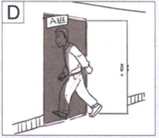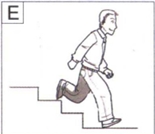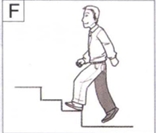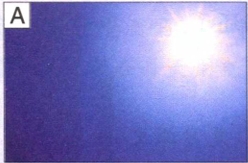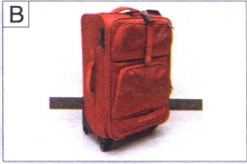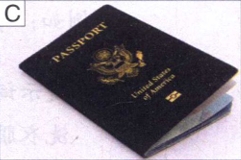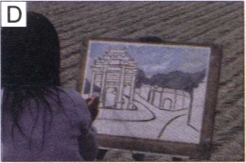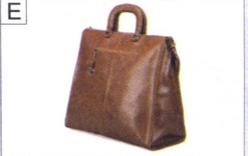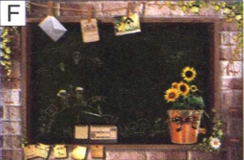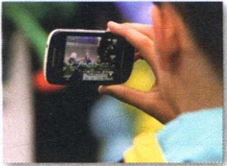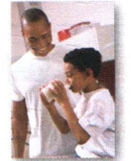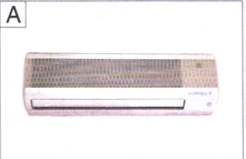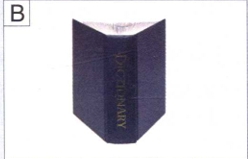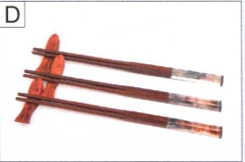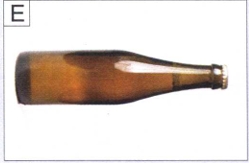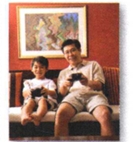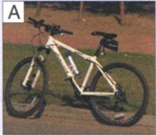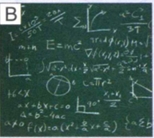热身 Warm-up
1 给下面的词语选择对应的图片 Match the pictures with the words.
 B
B C
C D
D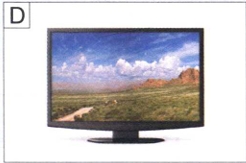 E
E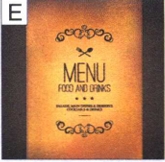 F
F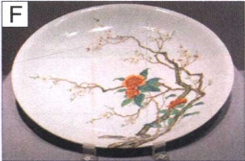
- càidān 菜单 ______
- pánzi 盘子 ______
- diànshì jiémù 电视节目 ______
- yuèliang 月亮 ______
- bīngxiāng 冰箱 ______
- xiāngjiāo 香蕉 ______
2 说一说在下面的时间中,你会做的三件事。 Talk about the three things you would do during the following periods of time.
| 时间 | 事情1 | 事情2 | 事情3 |
|---|---|---|---|
| 起床以后 qǐ chuáng yǐhòu | 刷牙 shuā yá | 洗脸 xǐ liǎn | 吃早饭 chī zǎofàn |
| 睡觉以前 shuì jiào yǐqián | |||
| 下课以后 xià kè yǐhòu | |||
| 考试以后 kǎo shì yǐhòu | |||
| 到家以后 dào jiā yǐhòu | |||
| 吃饭以后 chī fàn yǐhòu |
课文 Texts 1 在家 At home 14-1
周太太:客人就要来了,你怎么还不打扫房间啊?
周 明:别着急,我让孩子们打扫呢,客人来的时候,他们会把房间打扫干净。
周太太:那你也不能看电视啊。
周 明:你让我做什么?
周太太:先把茶和杯子放好,然后把冰箱里的西瓜拿出来。
周 明:太热了,我还是先把空调打开吧。
生词 New Words
1. 打扫 dǎsǎo v. to clean, to sweep
2. 干净 gānjìng adj. clean
3. 然后 ránhòu conj. then, after that
4. 冰箱 bīngxiāng n. refrigerator
课文 Texts 2 在打电话 On the phone 14-2
同事:你在忙什么呢?刚才打你的手机你也不接。
小刚:对不起,我刚洗了个澡,没听见。有什么事吗?
同事:我想问问你公司里的一些事情。
小刚:你先等一下,我去把电视关了。
同事:没关系,你先把电视节目看完吧,然后再给我回电话。
生词 New Words
5. 洗澡 xǐ zǎo v. to take a bath/shower
6. 节目 jiémù n. programme
课文 Texts 3 在小明家 At Xiaoming’s home 14-3
同学:今晚的月亮真漂亮,像白色的盘子一样。
小明:是啊,外边也不刮风,我们坐在外边一边看月亮一边吃东西,怎么样?
同学:好啊,我先把桌椅搬出去,然后你把水果拿过来,我们听叔叔阿姨讲讲他们年轻时候的故事。
小明:太好了!记得给大山打个电话,让他马上过来。
同学:不用打了,你听外边的声音,一定是大山。
生词 New Words
7. 月亮 yuèliang n. moon
8. 像 xiàng v. to be like
9. 盘子 pánzi n. plate
10. 刮风 guā fēng v. to be windy
11. 叔叔 shūshu n. uncle
12. 阿姨 āyí n. aunt
13. 故事 gùshi n. story
14. 声音 shēngyīn n. sound, voice
4 你吃过水果饭吗?你在饭馆的菜单上见过水果饭吗?你想学着做水果饭吗?其实做水果饭很简单,先把米饭做好,然后再把一块块新鲜的水果放进去,水果饭就做好了。你可以做苹果饭、香蕉饭,要是你愿意,还可以做西瓜饭。多吃新鲜水果对身体好。
生词 New Words
拼音课文 Texts in Pinyin
1、Zài jiā
Zhōu tàitai: Kèrén jiù yào lái le, nǐ zěnme hái bù dǎsǎo fángjiān a?
Zhōu Míng: Bié zháo jí, wǒ ràng háizimen dǎsǎo ne, kèrén lái de shíhou, tāmen huì bǎ fángjiān dǎsǎo gānjìng.
Zhōu tàitai: Nà nǐ yě bù néng kàn diànshì a.
Zhōu Míng: Nǐ ràng wǒ zuò shénme?
Zhōu tàitai: Xiān bǎ chā hé bēizi fànghǎo, ránhòu bǎ bīngxiāng lǐ de xīguā ná chulai.
Zhōu Míng: Tài rè le, wǒ háishi xiān bǎ kōngtiáo dǎ kāi ba.
2、Zài dǎ diànhuà
tóngshì: Nǐ zài máng shénme ne? Gāngcái dǎ nǐ de shǒujī yě bù jiē.
Xiǎogāng: Duìbuqǐ, wǒ gāng xǐle gè zǎo, méi tīngjiàn. Yǒu nǐ yě bù shēng me shì ma?
tóngshì: Wǒ xiǎng wènwen nǐ gōngsī lǐ de yìxiē shìqing.
Xiǎogāng: Nǐ xiān děng yíxià, wǒ qù bǎ diànshì guān le.
tóngshì: Méi guānxi, nǐ xiān bǎ diànshì jiémù kànwán ba, ránhòu zài gěi wǒ huí diànhuà.
3、Zài Xiǎomíng jiā
tóngxué: Jīn wǎn de yuèliang zhēn piàoliang, xiàng báisè de pánzi yíyàng.
Xiǎomíng: Shì a, wàibiān yě bù guā fēng, wǒmen zuò zài wàibiān yíbiān kàn yuèliang yíbiān chī dōngxi, zěnme yàng?
tóngxué: Hǎo a, wǒ xiān bǎ zhuōyǐ bān chulai, ránhòu nǐ bǎ shuǐguǒ ná guolai, wǒmen tīng shūshu āyí jiǎngjiang tāmen niánqīng shíhou de gùshi.
Xiǎomíng: Tài hǎo le! Jìde gěi Dàshān dǎ ge diànhuà, ràng tā mǎshàng guòlai.
tóngxué: Búyòng dǎ le, nǐ tīng wàibiān de shēngyīn, yídìng shì Dàshān.
4、Nǐ chī guo shuǐguǒ fàn ma? Nǐ zài fànguǎnr de càidān shang jiàn guo shuǐguǒ fàn ma? Nǐ xiǎng xuézhe zuò shuǐguǒ fàn ma? Qíshí zuò shuǐguǒ fàn hěn jiǎndān, xiān bǎ mǐfàn zuòhǎo, ránhòu zài bǎ yí kuàikuài xīnxiān de shuǐguǒ fàng jìnqu, shuǐguǒ fàn jiù zuòhǎo le. Nǐ kěyǐ zuò píngguǒ fàn, xiāngjiāo fàn, yàoshi nǐ yuànyì, hái kěyǐ zuò xīguā fàn. Duō chī xīnxiān shuǐguǒ duì shēntǐ hǎo.
“把”字句3:A把B+V+结果补语/趋向补语
The Ba-Sentence 3: A把B + V + Complement of Result/Direction
汉语中,表达对确定的人或事物产生某种结果或发生位置上的改变,可用“A把B+V+结果补语/趋向补语”。例如:
In Chinese, the structure “A把B + V + Complement of Result/Direction” can be used to indicate an action which is done on a definite person or thing and has brought a result to or has changed the position of the person or thing. For example:
| A把B | V | 结果补语/趋向补语 |
|---|---|---|
| 我把衣服 | 洗 | 干净了。 |
| 妈妈还没把饭 | 做 | 好呢。 |
| 请同学们把铅笔 | 拿 | 出来。 |
| 你把水果 | 拿 | 过来。 |
● 练一练 Practise
完成对话 Complete the dialogues.
(1)A: 妈妈,让我再看一会儿这个节目吧。
B: 好吧。你把这个节目________就去写作业。
(2)A: 房间里太热了。
B: ________。
(3)A: 我的行李呢?
B: 别着急,________房间里去了。
2 先……,再/又……,然后……
The Structure“先……,再/又……,然后……”
“先……,再/又……,然后……”表示动作的先后顺序。“再”表示动作还没有发生,“又”表示动作已经发生了。例如:
The structure“先……,再/又……,然后……(first…, then… and then…)”indicates the sequence of a series of actions. “再”indicates the action has not happened yet, while“又” indicates the action has already happened. For example:
(1)回家以后,我先做作业,然后吃饭。
(2)我先坐了一个小时公共汽车,又坐了一会儿地铁才到小刚家。
(3)你先把电视节目看完吧,然后再给我回电话。
(4)先把米饭做好,然后再把一块块新鲜的水果放进去。


